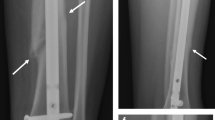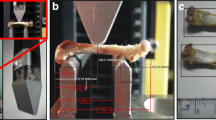Abstract
Usually follow-up of the healing process of bone fractures is by subjective assessment of standard X-rays, based on the clinician's personal experience. It is therefore impossible to completely avoid misjudgements in the evaluation of the mechanical stability. Other authors have reported that the mechanical response of bony structures to a knock impulse allows a definitive statement about the stiffness of a fracture. The practicability of computerised sonometry in computer-aided evaluation of the mechanical vibration reaction and the acoustic transmission of sound through osseous structures for assessing stability has been proved in experimental and clinical studies. We designed an animal study that would allow a systematic correlation between the diagnostic investigations in general use. As a main goal, this study tries to correlate sonography with other quantitative techniques, even if they are not used under everyday clinical conditions. Our results show that methods based on direct assessment of the mechanical stability between fracture fragments allow a more exact evaluation of fracture healing. This study helps to classify the results of computerised sonometry together with other diagnostic procedures used for the evaluation of fracture healing, and furthermore provides a basis for clinical interpretation of the findings of a new, non-invasive technique for precise quantitative assessment of fracture healing.
Similar content being viewed by others
References
Baldauf D (1992) Auswerteverfahren und Model lversuche bei der computerisierten Frakturdiagnostik. Thesis, Institute of Biomechanical Engeneering, Graz
Buturla E, Pope M (1975) A finite element wave propagation model of pathogenic and healing bone. In: Pope MH, McLay RW, Absher RG (eds) Proceedings of the 1st New England Bioengeneering Conference. Pergamon, New York, pp 36–45
Cann CE (1988) Quantitative CT for determination of bone mineral density: a review. Radiology 166:509–522
Cornelissen M, Van der Perre G, Martens M, Mulier JC 1984 Vibration measurements correlated with mechanical stability characteristics. A model with appliance to fracture healing assessment. Biomater Biomech 127–132
Fellinger M, Schanner A, Roupec R, Baldauf D, Leitgeb N, Jeran H, Grechenig W (1993) Computerised analysis of mechanical vibration reactions and sound transmission to assess the rate of stability in a dynamic model simulating healing fractures
Fellinger M, Schanner A, Szyszkowitz R, Leitgeb N, Stockenhuber
Fellinger M, Schanner A, Szyszkowitz R, Leitgeb N, Stockenhuber N, Roupec R (1992) Computerisierte Sonometrie - die Anwendung eines nicht invasiven Verfahrens zur Stabilitäts-beurteilung nach Frakturen. Aktuel Traumatol 22
Fellinger M, Schanner A, Szyszkowitz R, Leitgeb N, Stockenhuber N, Schweighofer F, Roupec R (1992) Die Analyse des mechanischen Schwingverhaltens und der akustischen Schallleitung knöcherner Strukturen als Möglichkeit zur Beurteilung der Knochenbruchheilung. Biomed Tech (Berlin) 37 [Suppl 1]:251–253
Laughton CM, Palmer SB, Porter RW (1984) The measurement of broadband ultrasonic attenuation in cancellous bone. Eng Med 13:89–91
Leitgeb N, Bodenteich A, Schweighofer F, Fellinger M (1990) Ultraschall Med 11:106–209
Leitgeb N, Lumpi KH, Schanner A, Fellinger M (1992) Quantitative Erfassung des Frakturheilungsverlaufes. Biomed Tech 37 [Suppl 1]:231–234
Mintowt-Czyz WJ, Fairclough WA, Mackie IG, Nokes L (1984) Assessment of fracture healing by vibration analysis. J Bone Joint Surg [Br] 65-B:286
Nokes L, Fairclough JA, Mintowt-Czyz WJ, Mackie J., Williams J (1984) Vibration analysis of human tibia: the effect of soft tissue on the output from skin-mounted accelerometers. J Biomed Eng 6:223–226
Nokes L, Mintowt-Czyz WJ, Mackie IG, Fairclough JA, Williams J (1985) Vibration analysis in the assessment of conservatively managed tibial fractures. J Biomed Eng 6:226–229
Pelker RR, Saha S (1985) Wave propagation across a bony discontinuity simulating a healing fracture. J Biomech, pp 745–753
Wong ATC, Goldsmith W, Sachman JL (1976) Flexural wave propagation in discontinuous model and in vitro tibia. J Biomech 9:813–825
Author information
Authors and Affiliations
Rights and permissions
About this article
Cite this article
Fellinger, M., Peicha, G., Eschberger, J. et al. Quantitative assessment of fracture healing. Arch Orthop Trauma Surg 113, 337–344 (1994). https://doi.org/10.1007/BF00426184
Received:
Issue Date:
DOI: https://doi.org/10.1007/BF00426184




